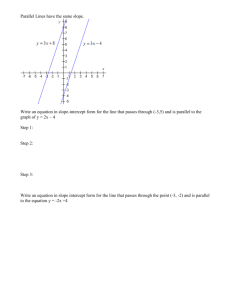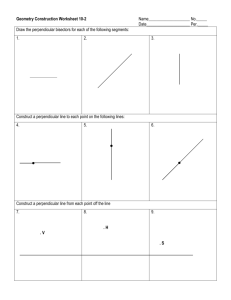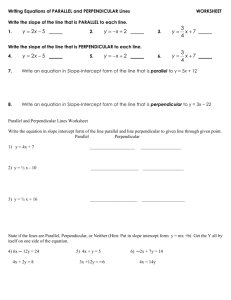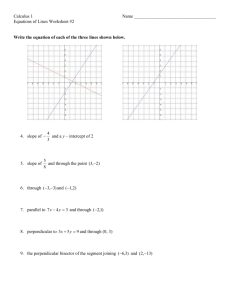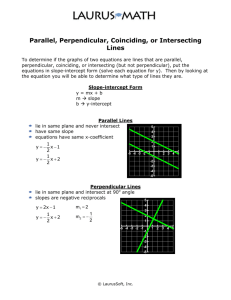This file will contain: Solving Equations Involving Parallel and
advertisement
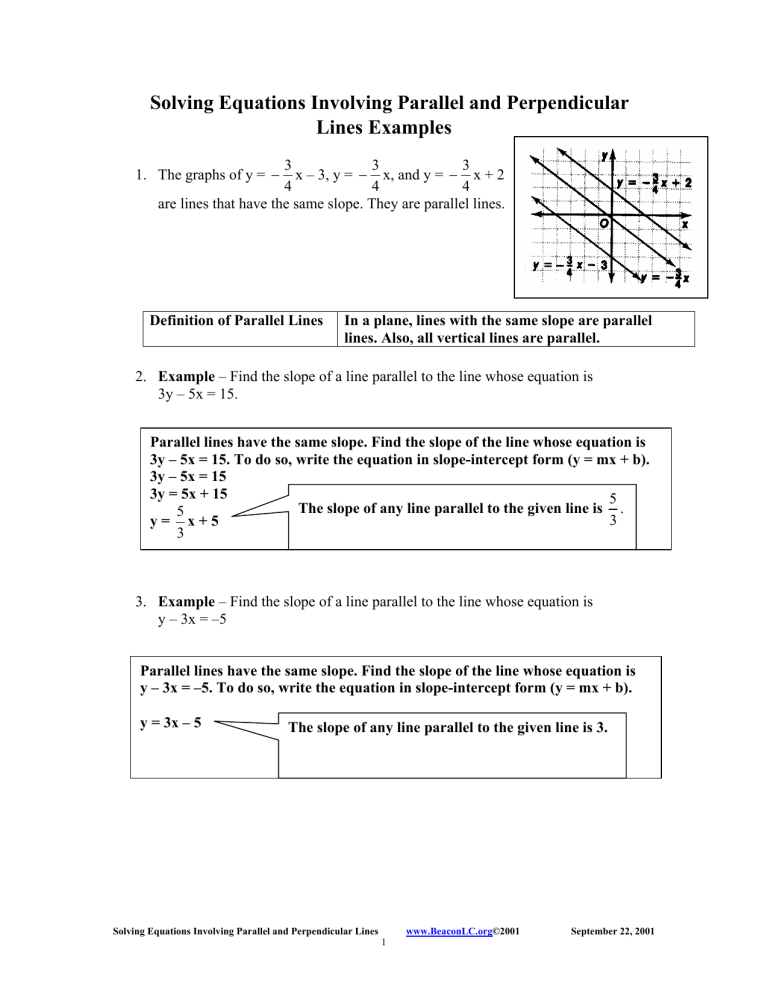
Solving Equations Involving Parallel and Perpendicular Lines Examples 3 3 3 x – 3, y = − x, and y = − x + 2 4 4 4 are lines that have the same slope. They are parallel lines. 1. The graphs of y = − Definition of Parallel Lines In a plane, lines with the same slope are parallel lines. Also, all vertical lines are parallel. 2. Example – Find the slope of a line parallel to the line whose equation is 3y – 5x = 15. Parallel lines have the same slope. Find the slope of the line whose equation is 3y – 5x = 15. To do so, write the equation in slope-intercept form (y = mx + b). 3y – 5x = 15 3y = 5x + 15 5 The slope of any line parallel to the given line is . 5 3 y= x+5 3 3. Example – Find the slope of a line parallel to the line whose equation is y – 3x = –5 Parallel lines have the same slope. Find the slope of the line whose equation is y – 3x = –5. To do so, write the equation in slope-intercept form (y = mx + b). y = 3x – 5 The slope of any line parallel to the given line is 3. Solving Equations Involving Parallel and Perpendicular Lines www.BeaconLC.org©2001 1 September 22, 2001 4. Example – Find an equation of the line that passes through (4, 6) and is parallel 2 to the line whose equation is y = x + 5. 3 2 2 (notice that y = x + 5 is in slope-intercept form. 3 3 2 Use (4, 6) and the slope to find the y-intercept. 3 y = mx + b Substitution Property 2 6 = ( )(4) + b 3 8 6 = +b 3 2 10 An equation of the line is y = x + 10 =b 3 3 3 The slope is 5. Thought Provoker – What is the relationship between the x- and y-intercepts of parallel lines? If the intercepts are nonzero, the ratio of the x- and y-intercepts of a given line is equal to the ratio of the x- and y-intercepts of any line parallel to the given line. 6. Example – Find an equation of the line that passes through (–1, 5) and is parallel to y – 5x = 1 Rewrite y – 5x = 1 into slope-intercept form Îy = 5x + 1 The slope of all parallel lines must be 5. Find “b” by substituting into slope-intercept formÎ5 = 5(–1) + b Îb = 10 Therefore y = 5x + 10 must be the equation of a line passing through (–1, 5) and parallel to y – 5x = 1. Solving Equations Involving Parallel and Perpendicular Lines www.BeaconLC.org©2001 2 September 22, 2001 7. Example – Find an equation of the line that passes through (–1, –3) and is parallel to 4x + 5y = 6. Rewrite 4x + 5y = 6 into slope-intercept form Îy = − The slope of all parallel lines must be − 4 6 x+ 5 5 4 . 5 Find “b” by substituting into slope-intercept formΖ3 = − 4 19 (–1) + b Îb = − 5 5 4 19 x − must be the equation of a line passing through (–1, –3) 5 5 and parallel to 4x + 5y = 6. Therefore y = − 5 3 x + 2 and y = − x + 6 are lines that are 3 5 perpendicular. Notice how their slopes are related: 5 3 ( )( − ) = –1 3 5 8. The graphs of y = The product of their slopes is –1 9. Definition of Perpendicular Lines In a plane, two nonvertical lines are perpendicular if and only if the product of their slopes is –1. Any vertical line is perpendicular to any horizontal line. 10. Here is a way to show that the slopes of any two nonvertical perpendicular lines in a plane have a product of –1. Consider a line that is neither vertical r nor horizontal, with slope (see graph). Now s consider rotating the line 900. Notice that the slope r of the new line (see graph) is − . The product of s r r the slopes of the two lines is ( )( − ) = –1. s s Solving Equations Involving Parallel and Perpendicular Lines www.BeaconLC.org©2001 3 September 22, 2001 11. Example – Find the slope of a line perpendicular to the line whose equation is y – 3x = 2. y – 3x = 2 y = 3x + 2 Write equation in slope-intercept form. The slope of the given line is 3. 3(m) = –1 1 m= − 3 Let m stand for the slope of the perpendicular line. The slope of any line perpendicular to the given line is − 1 3 12. Example – Find the slope of a line perpendicular to the line whose equation is 3x – 7y = 6. 3x – 7y = 6 3 6 y= x − 7 7 Write equation in slope-intercept form. The slope is 3 (m) = –1 7 7 m= − 3 3 7 Let m stand for the slope of the perpendicular line. The slope of any line perpendicular to the given line is − Solving Equations Involving Parallel and Perpendicular Lines www.BeaconLC.org©2001 4 7 3 September 22, 2001 13. Example – Find an equation of the line that passes through (4, 6) and is 2 perpendicular to the line whose equation is y = x + 5. 3 The slope of the given line is 2 (m) = –1 3 3 m= − 2 Let m stand for the slope of the perpendicular line. Use (4, 6) and the slope − y = mx + b 3 6 = ( − )(4) + b 2 12 = b 2 . 3 3 to find the y-intercept. 2 The y-intercept is 12. An equation of the line is y = − 3 x + 12 2 This could be written 3x + 2y = 24 14. Example – Find an equation of a line passing through (–1, –1) and is perpendicular to x + y = 6. y = –x + 6 ÎThe slope of the given line is –1. –1 (m) = –1 Let m stand for the slope of the perpendicular line. m=1 Use (–1, –1) and the slope 1 to find the y-intercept. y = mx + b –1 = (1)( –1) + b The y-intercept is 0. 0=b An equation of the line is y = x This could be written x – y = 0 Solving Equations Involving Parallel and Perpendicular Lines www.BeaconLC.org©2001 5 September 22, 2001 15. Example – Find an equation of a line that passes through (5, –2) and is perpendicular 4x + 3y = 12. y= − 4 4 x + 4 Î The slope of the given line is − . 3 3 4 (m) = –1 3 3 m= 4 − Let m stand for the slope of the perpendicular line. Use (5, –2) and the slope y = mx + b 3 –2 = ( )(5) + b 4 23 − =b 4 3 to find the y-intercept. 4 The y-intercept is − 23 . 4 This could be written 3x – 3y = 23 An equation of the line is y = 3 23 x − 4 4 16. Thought Provoker – Is it possible that two lines represented by 6x – 4y = 2 and 2x + 3y = 7 are perpendicular? Rewrite in slope-intercept form. 6x – 4y = 2 –4y = –6x + 2 3 1 y= x+ 2 2 Yes. They are perpendicular. 2x + 3y = 7 3y = –2x + 7 2 7 y= − x+ 3 3 Solving Equations Involving Parallel and Perpendicular Lines www.BeaconLC.org©2001 6 September 22, 2001 Name:___________________ Date:____________ Class:___________________ Solving Equations Involving Parallel and Perpendicular Lines Worksheet Find the slope of a line that is parallel and the slope of a line that is perpendicular to each line whose equation is given. 1. y = 4 x + 2 1 3 x – y = 11 3 8 2. y = 5 – 2x 5. 3. 2y = 3x – 8 6. x = 4y + 7 4. 6y – 5x = 0 State whether the graphs of the following equations are parallel, perpendicular, or neither. 8. x + y = 5 7. x + y = 5 x –y=5 x + y = –10 9. y = 2x 10. 2y + 3x = 5 y = 2x – 4 3y – 2x = 5 11. 3x – 8y = 11 12. 2y + 3x = 5 3x – 6y = 10 3y + 3x = 5 13. 14. 1 1 x+ y=2 2 3 1 2 3 x+ y= 3 3 5 2x – 3y = 4 2x + 4y = 7 Solving Equations Involving Parallel and Perpendicular Lines www.BeaconLC.org©2001 7 September 22, 2001 Find an equation of the line that passes through each given point and is parallel to the line with the given equation. 15. (4, 2); y = 2x – 4 16. (3, 1); y = 17. ( 1 x+6 3 1 1 , ); x + 2y = 5 2 3 18. (0, 0); 3x – y = 4 Find an equation of the line that passes through each given point and is perpendicular to the line with the given equation. 19. (–2, 0); y = –3x + 7 22. (12, 6); 20. (2, 5); 3x + 5y = 7 3 1 x+ y=2 4 2 21. (0, –4); 6x – 3y = 5 Find the value of “a” for which the graph of the first equation is perpendicular to the graph of the second equation. 23. y = ax – 5; 2y = 3x 25. y = 24. y = ax + 2; 3y – 4x = 7 a x – 6; 4x + 2y = 6 3 26. 3y + ax = 8; y = Solving Equations Involving Parallel and Perpendicular Lines www.BeaconLC.org©2001 8 3 x+2 4 September 22, 2001 Name:___________________ Date:____________ Class:___________________ Solving Equations Involving Parallel and Perpendicular Lines Worksheet Key Find the slope of a line that is parallel and the slope of a line that is perpendicular to each line whose equation is given. 1. y = 4 x + 2 2. y = 5 – 2x Parallel slope = 4; Perpendicular slope = − y = –2x + 5 Parallel slope = –2; Perpendicular slope = 3. 2y = 3x – 8 y= y= 1 2 3 x–4 2 Parallel slope = 4. 6y – 5x = 0 1 4 3 2 ; Perpendicular slope = − 2 3 5 x 6 5 6 Parallel slope = ; Perpendicular slope = − 6 5 5. 1 3 x – y = 11 3 8 y= 8 88 x − 9 3 Parallel slope = 6. x = 4y + 7 y= 8 9 ; Perpendicular slope = − 9 8 1 7 x − 4 4 Parallel slope = 1 ; Perpendicular slope = –4 4 State whether the graphs of the following equations are parallel, perpendicular, or neither. y = –x + 5 Both have same slope. x + y = 5 7. y = –x – 10 Lines are parallel. x + y = –10 Solving Equations Involving Parallel and Perpendicular Lines www.BeaconLC.org©2001 9 September 22, 2001 8. x+y=5 x –y=5 9. y = 2x y = 2x – 4 10. 2y + 3x = 5 3y – 2x = 5 11. 3x – 8y = 11 3x – 6y = 10 12. 2y + 3x = 5 3y + 3x = 5 13. 1 2 3 x+ y= 3 3 5 2x + 4y = 7 14. 1 1 x+ y=2 2 3 2x – 3y = 4 y = –x + 5 The product of the slopes is –1 Î (1)( –1) = –1 y=x–5 Lines are perpendicular. y = 2x Lines have same slope. y = 2x – 4 Lines are parallel. 3 5 x+ 2 2 2 5 y= x+ 3 3 The product of the slopes 3 2 is –1 Î ( − )( ) = –1 2 3 Lines are perpendicular. y= − 3 11 x− 8 8 1 5 y= x − 2 3 Neither 3 5 x+ 2 2 5 y=x+ 2 Neither y= y= − 1 x+ 2 1 y= − x+ 2 y= − 9 10 7 4 Lines have same slope. Lines are parallel. The product of the slopes 3 2 is –1 Î ( − )( ) = –1 2 3 Lines are perpendicular. 3 x+6 2 2 4 y= x − 3 3 y= − Solving Equations Involving Parallel and Perpendicular Lines www.BeaconLC.org©2001 10 September 22, 2001 Find an equation of the line that passes through each given point and is parallel to the line with the given equation. 15. (4, 2); y = 2x – 4 Use m = 2 and (4, 2) to find b. y = mx + b y = 2x – 6 2 = 2(4) + b b = –6 16. (3, 1); y = 1 x+6 3 Use m = 1= 1 and (3, 1) to find b. 3 1 (3) + b 3 y = mx + b 1 y= x 3 b=0 1 1 17. ( , ); x + 2y = 5 2 3 18. (0, 0); 3x – y = 4 1 5 x+ 2 2 1 1 1 Use m = − and ( , ); to find b. 2 2 3 1 1 1 = − ( )+b y = mx + b 3 2 2 1 7 7 y= − x + b= 2 12 12 x + 2y = 5 Îy = − 3x – y = 4 Îy = 3x – 4 Use m = 3 and (0, 0); to find b. 0 = 3 (0) + b y = mx + b b=0 y = 3x Solving Equations Involving Parallel and Perpendicular Lines www.BeaconLC.org©2001 11 September 22, 2001 Find an equation of the line that passes through each given point and is perpendicular to the line with the given equation. 19. (–2, 0); y = –3x + 7 m = –3 For a perpendicular line use m = 1 (–2) + b 3 2 b= 3 0= 20. (2, 5); 3x + 5y = 7 y = mx + b 1 2 y= x + 3 3 3 7 3x + 5y = 7 Îy = − x + 5 3 3 m= − 5 For a perpendicular line use m = 5 (2) + b 3 5 b= 3 5= 21. (0, –4); 6x – 3y = 5 1 and (–2, 0) 3 6x – 3y = 5 Îy = 2x − 5 and (2, 5) 3 y = mx + b 5 5 y= x + 3 3 5 3 m=2 For a perpendicular line use m = − –4 = − 1 (0) + b 2 b = –4 Solving Equations Involving Parallel and Perpendicular Lines y = mx + b 1 y= − x –4 2 www.BeaconLC.org©2001 12 1 and (0, –4) 2 September 22, 2001 22. (12, 6); 3 1 x+ y=2 4 2 3 1 3 x + y = 2 Îy = − x + 4 4 2 2 3 m= − 2 For a perpendicular line use m = 6= 2 (12) + b 3 b = –2 2 and (12, 6) 3 y = mx + b 2 y= x –2 3 Find the value of “a” for which the graph of the first equation is perpendicular to the graph of the second equation. 23. y = ax – 5; 2y = 3x Rewrite 2y = 3x in slope-intercept form. 3 y= x Compare slopes with y = ax – 5. 2 3 If a has a perpendicular slope then (a) = –1 2 2 a= − 3 24. y = ax + 2; 3y – 4x = 7 Rewrite 3y – 4x = 7 in slope-intercept form. 4 7 y= x+ Compare slopes with y = ax + 2. 3 3 4 If a has a perpendicular slope then (a) = –1 3 3 a= − 4 Solving Equations Involving Parallel and Perpendicular Lines www.BeaconLC.org©2001 13 September 22, 2001 25. y = a x – 6; 4x + 2y = 6 3 Rewrite 4x + 2y = 6 in slope-intercept form. a y = – 2x + 6 Compare slopes with y = x – 6. 3 a If a has a perpendicular slope then – 2 ( ) = –1 3 3 a= 2 26. 3y + ax = 8; y = 3 x+2 4 Rewrite 3y + ax = 8 in slope-intercept form. a 8 3 y =− x + Compare slopes with y = x + 2. 3 3 4 a 3 If a has a perpendicular slope then − ( ) = –1 3 4 a=4 Solving Equations Involving Parallel and Perpendicular Lines www.BeaconLC.org©2001 14 September 22, 2001 Student Name: __________________ Date: ______________ Solving Equations Involving Parallel and Perpendicular Lines Checklist 1. On questions 1 thru 6, did the student find the slope of a parallel line? a. Yes (30 points) b. 5 out of 6 (25 points) c. 4 out of 6 (20 points) d. 3 out of 6 (15 points) e. 2 out of 6 (10 points) f. 1 out of 6 (5 points) 2. On questions 1 thru 6, did the student find the slope of a perpendicular line? a. Yes (30 points) b. 5 out of 6 (25 points) c. 4 out of 6 (20 points) d. 3 out of 6 (15 points) e. 2 out of 6 (10 points) f. 1 out of 6 (5 points) 3. On questions 7 thru 14, did the student correctly determine the type of graphs? a. b. c. d. Yes (40 points) 7 out of 8 (35 points) 6 out of 8 (30 points) 5 out of 8 (25 points) e. f. g. h. 4 out of 8 (20 points) 3 out of 8 (15 points) 2 out of 8 (10 points) 1 out of 8 (5 points) 4. On questions 15 thru 18, did the student find the equation of a parallel line correctly? a. Yes (20 points) b. 3 out of 4 (15 points) c. 2 out of 4 (10 points) d. 1 out of 4 (5 points) 5. On questions 19 thru 22, did the student find the equation of a perpendicular line correctly? c. 2 out of 4 (10 points) d. 1 out of 4 (5 points) a. Yes (20 points) b. 3 out of 4 (15 points) 6. On questions 23 thru 26, did the student solve for “a” correctly? a. Yes (20 points) b. 3 out of 4 (15 points) c. 2 out of 4 (10 points) d. 1 out of 4 (5 points) Total Number of Points _________ Solving Equations Involving Parallel and Perpendicular Lines www.BeaconLC.org©2001 15 September 22, 2001 Name: ____________ Date:__________ Class:_____________ NOTE: The sole purpose of this checklist is to aide the teacher in identifying students that need remediation. It is suggested that teacher’s devise their own point range for determining grades. In addition, some students need remediation in specific areas. The following checklist provides a means for the teacher to assess which areas need addressing. 1. Does the student need remediation in content (finding the slope of a parallel and perpendicular line when given a linear equation) for questions 1 thru 6? Yes__________ No__________ 2. Does the student need remediation in content (identifying parallel and perpendicular lines when given a pair of linear equations) for questions 7 thru 14? Yes_________ No__________ 3. Does the student need remediation in content (finding the equation of a parallel line when given a point and a linear equation) for questions 15 thru 18? Yes__________ No__________ 4. Does the student need remediation in content (finding the equation of a perpendicular line when given a point and a linear equation) for questions 19 thru 22? Yes__________ No__________ 5. Does the student need remediation in content (finding the value of the constant term when given a perpendicular line) for questions 23 thru 26? Yes__________ No__________ A 150 points and above B 136 points and above C 112 points and above D 96 points and above F 95 points and below Sample Range of Points. Solving Equations Involving Parallel and Perpendicular Lines www.BeaconLC.org©2001 16 September 22, 2001
